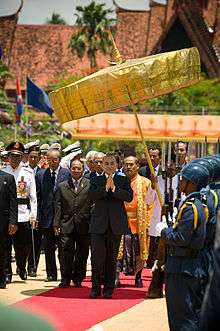Politics of Cambodia
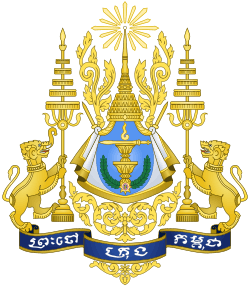 |
|---|
| This article is part of a series on the politics and government of Cambodia |
|
Monarchy |
|
| Foreign relations |
The Kingdom of Cambodia is a unitary state that is governed within the framework of a constitutional monarchy, in which the monarch serves as the head of state, while the prime minister is the head of government. The collapse of the Soviet Union in 1989 had set in motion events that led to withdrawal of the Vietnamese armed forces that had established their presence in the country since the fall of the Khmer Rouge in 1979.[1] The 1993 constitution, which is currently in force, was promulgated as a result of the 1991 Paris Peace Agreements, followed by the elections organized under the aegis of the United Nations Transitional Authority in Cambodia. The constitution proclaims a liberal, multiparty democracy in which powers are devolved to the three arms of the state: the executive, the judiciary and the legislature. Furthermore, the governing charter declares Cambodia to be an "independent, sovereign, peaceful, permanently neutral and non-aligned State."[2]
Executive power is exercised by the Royal Government, which constitutes of the Council of Ministers, headed by the Prime Minister. The Prime Minister is aided in his functions by members of the Council such as deputy prime ministers, senior ministers, other ministers and secretaries of state. Legislative power is vested in a bicameral legislature composed of the National Assembly, which has the power to vote on draft law, and the Senate that has the power of review. Upon the passage of legislation through the two chambers, the draft law is presented to the King for signing and promulgation. The judiciary is tasked with the protection of the rights and liberties of the citizens, and for being an impartial arbiter of disputes. The constitution provides for the independence of the judiciary and prohibits the delegation of its powers to the executive or the legislature. The Supreme Court is the highest court of the country and takes appeals from lower courts on questions of law. A separate body called the Constitutional Council is established to provide interpretations of the constitution and to resolve disputes related to the election of the members of the legislature.[3]
The Cambodian People's Party has dominated the political landscape since the 1997 armed clashes in Phnom Penh. Other prominent political parties include the royalist FUNCINPEC and the erstwhile Cambodia National Rescue Party that was dissolved by the Supreme Court in 2017. The Economist Intelligence Unit has called the system of government "authoritarian" in its 2017 Democracy Index.[4] This is a revision from the results published in the 2016 index that characterized the regime type as "hybrid".[5]
Executive branch
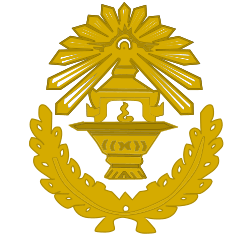
The Prime Minister of Cambodia is a representative from the ruling party of the National Assembly. He or she is appointed by the King on the recommendation of the President and Vice Presidents of the National Assembly. In order for a person to become Prime Minister, he or she must first be given a vote of confidence by the National Assembly.
The Prime Minister is officially the Head of Government in Cambodia. Upon entry into office, he or she appoints a Council of Ministers who are responsible to the Prime Minister. Officially, the Prime Minister's duties include chairing meetings of the Council of Ministers (Cambodia's version of a Cabinet) and appointing and leading a government. The Prime Minister and his government make up Cambodia's executive branch of government.
The current Prime Minister is Cambodian People's Party (CPP) member Hun Sen. He has held this position since the criticized 1998 election, one year after the CPP staged a bloody coup in Phnom Penh[6][7] to overthrow elected Prime Minister Prince Norodom Ranariddh, president of the FUNCINPEC party. Hun Sen has vowed to rule until he is 74. Hun Sen is a former Khmer Rouge member who defected and oversaw Cambodia's rise from the ashes of war. His government is regularly accused of ignoring human rights and suppressing political dissent. After the 2013 election results, disputed by Hun Sen's opposition, demonstrators were injured and killed in Cambodia in protests in the capital where a reported 20,000 protesters gathered, some clashing with riot police.[8] From a humble farming background, Hun Sen was just 33 when he took power in 1985 and is now in the company of enduring leaders such as Zimbabwe's Robert Mugabe and Kazakhstan's Nursultan Nazarbayev.[9]
Legislative branch
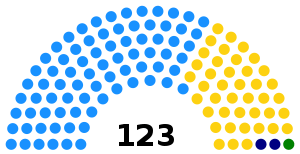
The legislative branch of the Cambodian government is made up of a bicameral parliament.
- The National Assembly (Radhsaphea) has 125 members, elected for a five-year term by proportional representation.
- The Senate (Protsaphea) has 62 members. Two of these members are appointed by the King, two are elected by the lower house of the government, and the remaining fifty-seven are elected popularly by "functional constituencies." Members in this house serve a six-year term.
The official duty of the Parliament is to legislate and make laws. Bills passed by the Parliament are given to the King who gives the proposed bills royal assent. The King does not have veto power over bills passed by the National Assembly and thus, cannot withhold royal assent. The National Assembly also has the power to dismiss the Prime Minister and his government by a two-thirds vote of no confidence.
Senate
The upper house of the Cambodian legislature is called the Senate. It consists of sixty-one members. Two of these members are appointed by the King, two are elected by the lower house of the government, and the remaining fifty-seven are elected popularly by electors from provincial and local governments, in a similar fashion to the Senate of France. Members in this house serve six-year terms.
Prior to 2006, elections had last been held for the Senate in 1999. New elections were supposed to have occurred in 2004, but these elections were initially postponed. On January 22, 2006, 11,352 possible voters went to the poll and chose their candidates. This election was criticized by local monitoring non-governmental organizations as being undemocratic.[10]
As of 2006, the Cambodian People's Party holds forty-three seats in the Senate, constituting a significant majority. The two other major parties holding seats in the Senate are the Funcinpec party (holding twelve seats) and the Sam Rainsy Party (holding two seats).
National Assembly
The lower house of the legislature is called the National Assembly. It is made up of 123 members, elected by popular vote to serve a five-year term. Elections were last held for the National Assembly in July 2013.
In order to vote in legislative elections, one must be at least eighteen years of age. However, in order to be elected to the Legislature, one must be at least twenty-five years of age.
The National Assembly is led by a President and two Vice Presidents who are selected by Assembly members prior to each session.
As of 2013, the Cambodian People's Party holds a majority of the seats in the National Assembly, controlling 68 out of the 123 seats. The Cambodia National Rescue Party holds the remaining 55 seats.
Political parties and elections
.jpg)
.jpg)
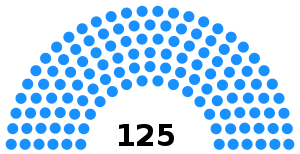 | |||||
| Party | Votes | % | Seats | +/– | |
|---|---|---|---|---|---|
| Cambodian People's Party | 4,889,113 | 76.85 | 125 | +57 | |
| FUNCINPEC | 374,510 | 5.89 | 0 | 0 | |
| League for Democracy Party | 309,364 | 4.86 | 0 | 0 | |
| Khmer Will Party | 212,869 | 3.35 | 0 | New | |
| Khmer National United Party | 99,377 | 1.56 | 0 | New | |
| Grassroots Democratic Party | 70,567 | 1.11 | 0 | New | |
| Beehive Social Democratic Party | 56,024 | 0.88 | 0 | New | |
| Khmer Anti-Poverty Party | 55,298 | 0.87 | 0 | 0 | |
| Khmer United Party | 48,785 | 0.77 | 0 | New | |
| Cambodian Nationality Party | 45,370 | 0.71 | 0 | 0 | |
| Khmer Republican Party | 41,631 | 0.65 | 0 | New | |
| Cambodian Youth Party | 39,333 | 0.62 | 0 | New | |
| Dharmacracy Party | 29,060 | 0.46 | 0 | New | |
| Khmer Economic Development Party | 23,255 | 0.37 | 0 | 0 | |
| Khmer Rise Party | 22,002 | 0.35 | 0 | New | |
| Ponleu Thmey Party | 13,509 | 0.21 | 0 | New | |
| Cambodia Indigenous People's Democracy Party | 10,197 | 0.16 | 0 | New | |
| Our Motherland Party | 9,174 | 0.14 | 0 | New | |
| Democratic Republican Party | 8,591 | 0.14 | 0 | 0 | |
| Reaksmey Khemara Party | 4,212 | 0.07 | 0 | New | |
| Invalid/blank votes | 594,659 | – | – | – | |
| Total | 6,956,900 | 100 | 125 | +2 | |
| Registered voters/turnout | 8,380,217 | 83.02 | – | – | |
| Source: National Election Committee | |||||
| Party | Votes | % | Seats | ||
|---|---|---|---|---|---|
| Cambodian People's Party | 8,880 | 77.81% | 46 | ||
| Sam Rainsy Party | 2,503 | 22.19% | 11 | ||
| Total (turnout) | 11,383 | 57 | |||
| Source: MYsinchew.com, RFA | |||||
- In addition to the general election, the King and National Assembly each choose two Senators, bringing the total to 61 members.
Judicial branch
The judicial branch is independent from the rest of the government, as specified by the Cambodian Constitution. The highest court of judicial branch is the Supreme Council of the Magistracy. Other, lower courts also exist. Until 1997, Cambodia did not have a judicial branch of government despite the nation's Constitution requiring one.
The main duties of the judiciary are to prosecute criminals, settle lawsuits, and, most importantly, protect the freedoms and rights of Cambodian citizens. However, in reality, the judicial branch in Cambodia is highly corrupt and often serves as a tool of the executive branch to silence civil society and its leaders.[11] There are currently 17 justices on the Supreme Council.
Monarchy
Cambodia is a constitutional monarchy, i.e. the King reigns but does not rule, in similar fashion to Queen Elizabeth II of the United Kingdom. The King is officially the Head of State and is the symbol of unity and "perpetuity" of the nation, as defined by Cambodia's constitution.[12]
From September 24, 1993 through October 7, 2004, Norodom Sihanouk reigned as King, after having previously served in a number of offices (including King) since 1941. Under the Constitution, the King has no political power, but as Norodom Sihanouk was revered in the country, his word often carried much influence in the government. While such views are not prevalent in Cambodia, his word was respected by his subjects. The King, often irritated over the conflicts in his government, several times threatened to abdicate unless the political factions in the government got along. This put pressure on the government to solve their differences. This influence of the King was often used to help mediate differences in government.
After the abdication of King Norodom Sihanouk in 2004, he was succeeded by his son Norodom Sihamoni. While the retired King was highly revered in his country for dedicating his lifetime to Cambodia, the current King has spent most of his life abroad in France. Thus, it remains to be seen whether the new King's views will be as highly respected as his father's.
Although in the Khmer language there are many words meaning "king", the word officially used in Khmer (as found in the 1993 Cambodian Constitution) is preahmâhaksat (Khmer regular script:![]()
On the occasion of HM King Norodom Sihanouk's retirement in September 2004, the Cambodian National Assembly coined a new word for the retired king: preahmâhaviraksat (Khmer regular script:![]()
As preahmâhaviraksat, Norodom Sihanouk retained many of the prerogatives he formerly held as preahmâhaksat and was a highly respected and listened-to figure. Thus, in effect, Cambodia could be described as a country with two Kings during Sihanouk's lifetime: the one who was the Head of State, the preahmâhaksat Norodom Sihamoni, and the one who was not the Head of State, the preahmâhaviraksat Norodom Sihanouk.
Sihanouk died of a pulmonary infarction on October 15, 2012.
Succession to the throne
Unlike most monarchies, Cambodia's monarchy is not necessarily hereditary and the King is not allowed to select his own heir. Instead, a new King is chosen by a Royal Council of the Throne, consisting of the president of the National Assembly, the Prime Minister, the President of the Senate, the First and Second Vice Presidents of the Senate, the Chiefs of the orders of Mohanikay and Thammayut, and the First and Second Vice-President of the Assembly. The Royal Council meets within a week of the King's death or abdication and selects a new King from a pool of candidates with royal blood.
It has been suggested that Cambodia's ability to peacefully appoint a new King shows that Cambodia's government has stabilized incredibly from the situation the country was in during the 1970s (see History of Cambodia).
International organization participation
ACCT, AsDB, ASEAN, ESCAP, FAO, G-77, IAEA, IBRD, ICAO, ICC, ICRM, IDA, IFAD, IFC, IFRCS, ILO, IMF, IMO, Intelsat (nonsignatory user), International Monetary Fund, Interpol, IOC, ISO (subscriber), ITU, NAM, OPCW, PCA, UN, UNCTAD, UNESCO, UNIDO, UPU, WB, WFTU, WHO, WIPO, WMO, WTO, WToO, WTrO (applicant)
International rankings
| Organization | Survey | Ranking | Score |
|---|---|---|---|
| Transparency International | Corruption Perceptions Index (2012) | 164 Out of 184 | 89.13% |
| United Nations Development Programme | Human Development Index (2012) | 139 Out of 184 | 75.5% |
| World Gold Council | Gold reserve (2010) | 65 Out of 110 | 60% |
| Reporters Without Borders | Worldwide Press Freedom Index (2012) | 117 out of 179 | 65.3% |
| The Heritage Foundation | Indices of Economic Freedom (2012) | 102 Out of 179 | 57% |
| Global Competitiveness Report | World Economic Forum (2012) | 97 out of 142 | 68.3% |
Provincial and local governments
Below the central government are 24 provincial and municipal administration.[13] (In rural areas, first-level administrative divisions are called provinces; in urban areas, they are called municipalities.) The administrations are a part of the Ministry of the Interior and their members are appointed by the central government.[13] Provincial and municipal administrations participate in the creation of nation budget; they also issue land titles and license businesses.[13]
Since 2002, commune-level governments (commune councils) have been composed of members directly elected by commune residents every five years.[14]
In practice, the allocation of responsibilities between various levels of government is uncertain.[13] This uncertainty has created additional opportunities for corruption and increased costs for investors.[13]
References
- ↑ "Lessons from Cambodia's Paris Peace Accords for Political Unrest Today". United States Institute of Peace. Retrieved 2018-06-14.
- ↑ Miller, Laurel E.; Aucoin, Louis (2010). Framing the State in Times of Transition: Case Studies in Constitution Making. US Institute of Peace Press. p. 210. ISBN 9781601270559.
- ↑ "Overview of the Cambodian History, Governance and Legal Sources - GlobaLex". www.nyulawglobal.org. Retrieved 2018-06-14.
- ↑ "Democracy Index 2017". www.eiu.com. Retrieved 2018-06-14.
- ↑ "Democracy Index 2016 - The Economist Intelligence Unit". www.eiu.com. Retrieved 2018-06-14.
- ↑ "Archived copy" (PDF). Archived from the original (PDF) on 2007-06-27. Retrieved 2007-06-27.
- ↑ http://www.hri.org/docs/statedep/1997/97-07-08.std.html
- ↑ http://www.channelnewsasia.com/news/asiapacific/cambodia-protest-clashes/814406.htmlRetrieved September-16-2013 Archived 2013-09-26 at the Wayback Machine.
- ↑ Andrew R.C.Marshall; Prak Chan Thul (18 September 2013). "Analysis: Punished at the polls, Cambodia's long-serving PM is smiling again". Reuters. Retrieved 19 September 2013.
- ↑ "Ruling party wins Cambodia poll". 19 May 2018 – via news.bbc.co.uk.
- ↑ "Essential Background: Overview of human rights issues in Cambodia". Human Rights Watch. 31 December 2005.
- ↑ "Cambodia 1993 (rev. 2008)". Constitute. Retrieved 17 April 2015.
- 1 2 3 4 5 Private Solutions for Infrastructure in Cambodia: A Country Framework Report. World Bank (2002), p65. ISBN 0-8213-5076-5.
- ↑ "Account Suspended". www.embassyofcambodia.org.nz.
External links
- Global Integrity Report: Cambodia reports on corruption and anti-corruption in Cambodia
Royalty
- King of Cambodia, Norodom Sihamoni Official Website of King Norodom Sihamoni
- King of Cambodia, Norodom Sihanouk Official Website of former King Norodom Sihanouk
Official
- Cambodia.gov.kh Official Royal Government of Cambodia Website (English Version) (Cambodia.gov.kh Khmer Version)
- CDC Council for the Development of Cambodia
- Conseil Constitutionnel du Cambodge Constitution council of Cambodia
- Department of Fisheries
- Food Security and Nutrition Information System Cambodia
- Ministry of Commerce
- Ministry of Culture and Fine Arts
- Ministry of Economy and Finance
- Ministry of Education, Youth and Sport
- Ministry of Environment
- Ministry of Posts and Telecommunications
- Ministry of Public Works and Transport
- Ministry of Tourism
- NiDA National Information Communications Technology Development Authority
- Ministry of Planning
- NIS National Institute of Statistics of Cambodia
- Ministry of Interior
- N.C.C.T National Committee for Counter Trafficking in person
_(crop).jpg)
.jpg)
